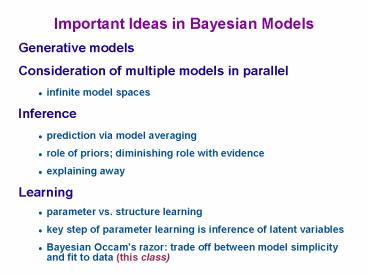Important Ideas in Bayesian Models PowerPoint PPT Presentation
1 / 14
Title: Important Ideas in Bayesian Models
1
Important Ideas in Bayesian Models
- Generative models
- Consideration of multiple models in parallel
- infinite model spaces
- Inference
- prediction via model averaging
- role of priors diminishing role with evidence
- explaining away
- Learning
- parameter vs. structure learning
- key step of parameter learning is inference of
latent variables - Bayesian Occam's razor trade off between model
simplicity and fit to data (this class)
2
Important Technical Issues To Come
- Approximate inference techniques
- Markov chain Monte Carlo
- particle filters
- variational approximations
- Special inference techniques
- EM, forward-backward algorithm
- Kalman filter update
- Representing structured data
- grammars
- relational schemas (e.g., paper authors, topics)
- multiple levels of abstraction
- Nonparametric models
- flexible models that grow in complexity as the
data justifies
3
Ockham's Razor
medieval philosopher and monk
tool for cutting (metaphorical)
- If two hypotheses are equally consistent with the
data, prefer the simpler one. - simplicity
- can accommodate fewer observationssmootherfewer
parametersrestricts predictions more - e.g., 2nd vs. 4th order polynomial
- e.g., small rectangle vs. large rectangle in
Tenenbaum model - e.g., 2-bump vs. 10-bump mixture of Gaussians
4
Motivating Ockham's Razor
PRIORS
- Aesthetic considerations
- A theory with mathematical beauty is more likely
to be right (or believed) than an ugly one, given
that both fit the same data. - Past empirical success of the principle
- Coherent inference, as embodied by Bayesian
reasoning, automatically incorporates Ockham's
razor - Two theories H1 and H2
LIKELIHOODS
5
Ockham's Razor with Priors
- Jeffreys (1921)
- more complex hypotheses should have smaller
priors - requires a numerical rule for assessing
complexity - e.g., Vapnik-Chervonenkis (VC) dimension
- e.g., Minimum Description Length (MDL)
6
Rissanen (1976)Minimum Description Length
- Prefer models that can communicate the data in
the smallest number of bits. - The preferred hypothesis H for explaining data D
minimizes - (1) length of the description of the hypothesis
(Ockham's razor)(2) length of the description of
the data with the help of the chosen theory
L length
7
MDL Bayes
- L some measure of length (complexity)
- MDL prefer hypothesis that min. L(H) L(DH)
- Bayes rule implies MDL principle
- P(HD) P(DH)P(H) / P(D)
- log P(HD) log P(DH) log P(H) log P(D)
L(DH) L(H) const
8
Subjective vs. Objective Priors
- subjective or informative prior specific,
definite information about a random variable - objective or uninformative prior vague, general
information - e.g., uniform over some range
- philosophical arguments for
- maximum entropy
- 1/(?(1-?)) for ? in 0,1
9
Moving Away from Subjective Priors
- Coin flipping example
- H1 coin has two headsH2 coin has a head and a
tail - Consider 5 flips producing HHHHH
- H1 could produce only this sequenceH2 could
produce HHHHH, but also HHHHT, HHHTH, ... TTTTT - P(HHHHH H1) 1, P(HHHHH H2) 1/32
- H1 is easier to reject based on observations
- H2 pays the price of having a lower likelihood
via the fact it can accommodate a greater range
of observations
10
Simple and Complex Hypotheses
H2
H1
11
Bayes Factor
- BIC is approximation to Bayes factor
12
Relativity Example
- Explain deviation in Mercury's orbit with respect
to prevailing theory - E Einstein's theory a true deviationF
fudged Newtonian theory a observed
deviation
13
Relativity Example (Continued)
- Subjective Ockham's razor
- result depends on one's belief about P(aF)
- Objective Ockham's razor
- for Mercury example, RHS is 15.04
- Applies to generic situation
14
Simple and Complex Hypothesis Classes
- E.g., 1st and 2nd order polynomials
- Hypothesis class is parameterized by w
v

